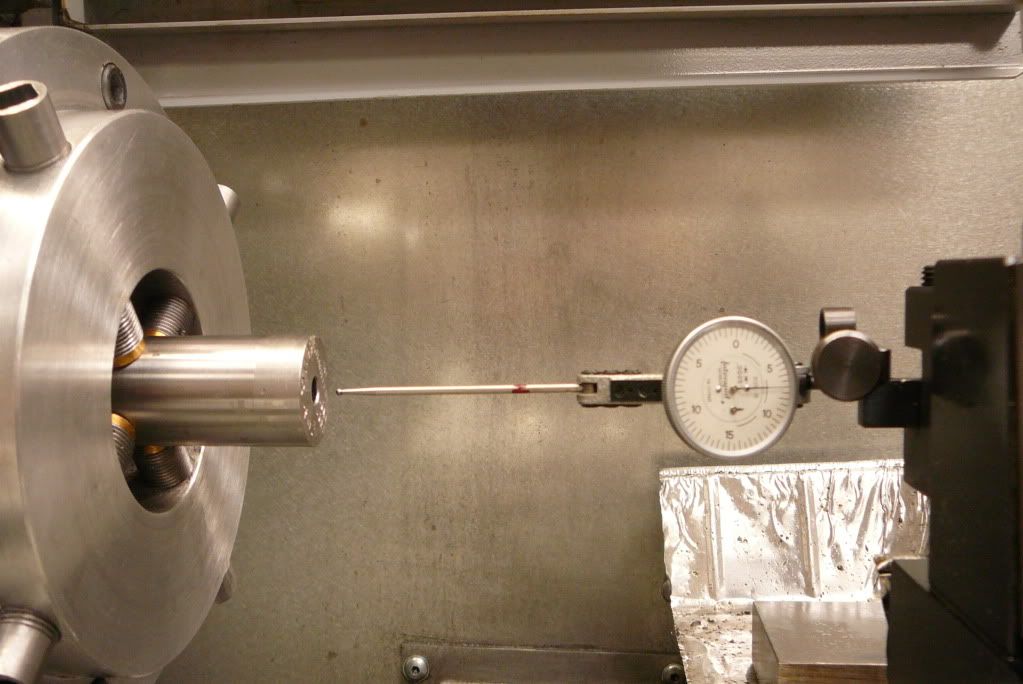Re: PTG Dual Pilot Range Rods
<div class="ubbcode-block"><div class="ubbcode-header">Originally Posted By: Dave Tooley</div><div class="ubbcode-body">I know a lot of people are going to disagree with me and that's fine. I've been building match winning record setting rifles for over 25 years. I'd say at least 20+ years using a long stem indicator on the breech end and nothing more than a snug fitting bushing on the muzzle to indicate on. My rifles have set over 35 world records based purely on accuracy. I can appreciate the Gritters method but I have never seen the need to explore an alternative setup.
There are so many factors that affect the concentricity of the chamber. Bore straightness is one, they do wonder around a bit, some more than others and mostly on the breech end. Here's an example of one issue that has to be considered. Look at the relationship/location of the bushing on the reamer. I have never heard one word of discussion about that. Some speak of tenths like they can accually work to those tolerances. It doesn't happen but in this case tenths can show up in the finished chamber. The distance between the bushing and the throat of a reamer can have an affect on chamber concentricity. Crooked bore and a bushing that is way out in front means misalignmant. Example. I have one reamer, a magnum on a 2.5" case, that was ground on a blank for a 2.850" case length. I don't use that one much but I have never gotten what I call a perfectly concentric chamber. The reason, crooked barrels and a bushing that is located way out in front that's trying to follow the bore. All the rifles shot just fine but that reamer and the chambers are not quit right. That is just one of the factors that affecting chamber concentricity.
There many ways to skin this cat and get acceptable results but I view rods as a crutch that can introduce errors and remove the most important piece of equipment from the process. Your brain and applying basic machining techniques to this very very simple task. In 2011 and 2012 I've chambered over 500 barrels using this technique with no problems.
Get yourself a simple 3X jewelers loupe with a 3 1/2" focal length. About $20-$30. No need for a borescope. After you chamber a barrel patch it out clean, hold it up to a light and focus on the freebore in the chamber. It will in all likelyhood be an enlightening experience. There should be a concentric shadow as the freebore transitions to the rifling. Very easy to pick up just a few tenths misalignment. </div></div>
Ok I will fully admit my ignorance here! I am confused and or in way over my head
When I think of getting a barrel true in a lathe for preparation for threading, chambering, etc, I think of it this way. I work through the headstock. I select a range rod with close fitting bushing and slowly work each end of the barrel, indicating of said range rod, to as little total indicated run out as I can get. Sometimes I can get it pretty dam good to say within .0003 or so using a .0001 dial indicator. From there I am off and running. I do one end at a time and complete all the machining in two operations (chamber then flip and crown + thread). I have a fairly used lathe but tolerances are ok, not some tool room deal but it works. I have every bit of .0005” change between a warmed up headstock and cold. I indicate on a hot one.
Here is my confusion. If you’re indicating on the bore directly with an indicator I am guessing its something like this:
http://www.grainger.com/Grainger/MAHRFEDERAL-INC-Dial-Test-Indicator-5RHF1
Since the indicator will bounce up and down on each land and groove how do you ever know where you end up? Are you just looking for a consistent measurement land to groove all the way around and therefore because each measurement is consistent the theory is the bore is running consistent.
OR
Are you measuring on a single land or grove at a time by measuring the lateral movement as you run the indicator all the way in and all the way back out?
I understand that a bore may change throughout the barrel. And I like the idea of chasing this change for a more consistent / concentric chamber.
I am very fascinated by this process but am completely lost
Thanks





